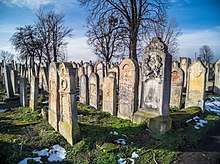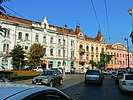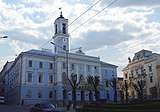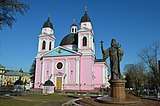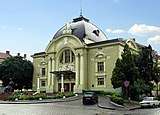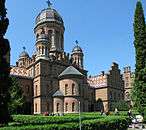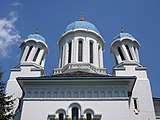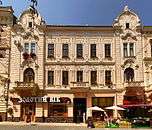Chernivtsi
Chernivtsi (Ukrainian: Чернівці́, romanized: Černivci [tʃern⁽ʲ⁾iu̯ˈts⁽ʲ⁾i] Polish: Czerniowce, Romanian: Cernăuți; see also other names) is a city in western Ukraine. It is situated on the upper course of the River Prut, and is the administrative center of Chernivtsi Oblast (province) – the northern, Ukrainian part of the historical region of Bukovina. Administratively, Chernivtsi is a city of regional significance. At the time of the 2001 Ukrainian Census, the population of the city was 240,600.[4] Current population: 295,366 (2015 est.)[5]
Chernivtsi Чернівці | |
|---|---|
 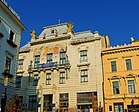 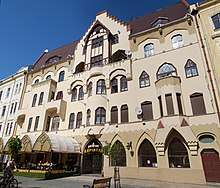  | |
Flag 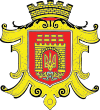 Coat of arms | |
| Nickname(s): | |
.png) The Chernivtsi City Municipality (center) on the map of Chernivtsi Oblast. | |
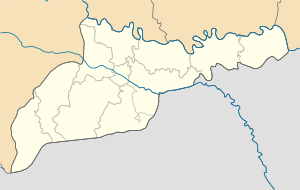 Chernivtsi Location of Chernivtsi in Ukraine  Chernivtsi Chernivtsi (Ukraine) | |
| Coordinates: 48°18′0″N 25°56′0″E | |
| Country | |
| Oblast | |
| Municipality | Chernivtsi Municipality |
| First mentioned | 1408 |
| City rights | 14th century |
| Subdivisions |
|
| Government | |
| • Mayor | Oleksiy Kaspruk (independent)[3] |
| Area | |
| • Total | 153 km2 (59 sq mi) |
| Elevation | 248 m (814 ft) |
| Population (2015) | |
| • Total | 266,366 |
| • Density | 1,700/km2 (4,500/sq mi) |
| Time zone | UTC+2 (EET) |
| • Summer (DST) | UTC+3 (EEST) |
| Postal code | 58000 |
| Area code(s) | +380 372 |
| Vehicle registration | CE/26 |
| Sister cities | Salt Lake City, Konin, Suceava, Nazareth Illit, Saskatoon, Klagenfurt |
| Website | city chernivtsy |
Chernivtsi is currently viewed as one of Western Ukraine's main cultural centers. The city is also considered one of Ukraine's important educational and architectural sites. Historically a cosmopolitan community, Chernivtsi was once dubbed "Little Vienna"[1][2] and "Jerusalem upon the Prut". Chernivtsi is currently twinned with seven other cities around the world. The city is a major regional rail and road transportation hub, also housing an international airport.
Names
Aside from its Ukrainian name of Chernivtsi, the city is also known by several different names in various languages, which still are used by the respective population groups much as they used to be throughout the city's history, either in connection with the rule by one country or another or independently from it: Romanian: Cernăuți; German: Czernowitz; Polish: Czerniowce; Hungarian: Csernovic, Russian: Черновцы́, translit. Chernovtsy (In Russian until 1944: Чернови́цы, translit. Chernovitsy).[6] In the times of Halych-Volyn Principality the city's name was Chern.
In "Documents of Western Russia" (Russian: Акты Западной России) published in Saint Petersburg in 1846 (Volume 1, page 32, document #21), the city is mentioned as Chernovtsi (Russian: Черновьци).
History
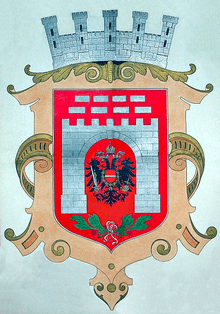

Archeological evidence discovered in the area surrounding Chernivtsi indicates that a population inhabited it since the Neolithic era. Later settlements included those of the Cucuteni-Trypillian culture,[7] the Corded Ware culture; artifacts from the Bronze and Iron Ages were also found in the city. In the Middle Ages there lived East Slavic tribes White Croats and Tivertsi.[8]
A fortified settlement located on the left (north-eastern) shore of the Prut dates back to the time of the Principality of Halych and is thought to have been built by Grand Prince Yaroslav Osmomysl.[9] Legendary accounts refer to this fortress-city as Chern', or Black city; it is said to owe its name to the black color of the city walls, built from dark oak layered with local black-colored soil.[10] This early stronghold was destroyed during the Mongol invasion of Europe by Boroldai in 1259. However, the remaining ramparts of the fortress were still used for defense purposes; in the 17th century they were augmented with several bastions, one of which is still extant.
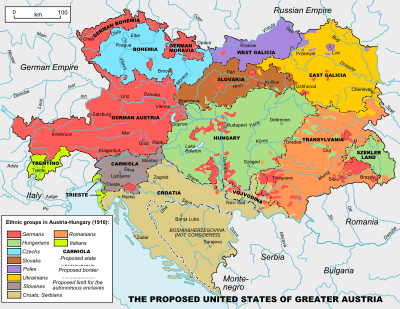
Following the destruction of the fortress, later settlements in the area centered on the right (south-western) shore of the Prut River, at a more strategically advantageous, elevated location. In 1325, when Kingdom of Poland seized control of Galicia, and came into contact with the early Vlach (Romanian) feudal formations, a fort was mentioned under the name Țețina; it was defending the ford and crossing point on the Prut River. It was part of a group of three fortifications, the other two being the fortress of Hotin on the Dniester to the east, and a fort on the Kolachin River, an upriver tributary of Prut.
Between 1359 and 1775, the city and its surroundings were part of the Principality of Moldavia, one of the historic provinces of Romania; the city being the administrative center of the homonymous ținut (county).[11] The name Cernăuți/Chernivtsi is first attested in a document by Alexandru cel Bun (Alexander the Good) on 8 October 1408.[12] In Ottoman sources, the city was mentioned as "Çernovi", a phonetic transliteration of a Latin cognomen meaning new castle (see French Castelnau[13] or Welsh Carno).
In 1775, the northwestern part of the territory of Moldavia was annexed by the Habsburg Empire; this region became known as Bukovina. The city became the region's capital, which in 1849 was raised in status and became known as the Duchy of Bukovina, a crownland of the Austrian Empire. The city received Magdeburg rights.[14] The city began to flourish in 1778 when Knight Karl von Enzenberg was appointed the chief of the Military Administration. He invited many merchants, craftsmen and entrepreneurs to help develop trade and other businesses. Saint Peter's Fairs ( 1–15 July) had given a new vibrant impulse to the market development from 1786. In the late 19th century the German language—due to the Habsburg and the very important Jewish influence—became the lingua franca and more and more newspapers were edited in German, also a remarkable literary production in German began in this period, featuring most prominently Karl Emil Franzos.[15]
During the 19th and early 20th century, Chernivtsi became a center of both Romanian and Ukrainian national movements. In 1908, it was the site of the first Yiddish language conference, the Czernowitz Conference, coordinated by Nathan Birnbaum. When Austria-Hungary dissolved in 1918, followed by two years of political uncertainty in Europe due to the aftermath of World War I, the city and its surrounding area became part of the Kingdom of Romania, which gained worldwide diplomatic recognition by the end of 1920.[16] During those two years, even most city residents did not know of which country they were citizens, with most assuming Czernowitz still belonged to Austria-Hungary.[17] German remained the lingua franca of the city and its suburbs for another decade. In 1930, the city reached a population of 112,400: 26.8% Jews, 23.2% Romanians, 20.8% Germans, 18.6% Ukrainians, the remainder Poles and others. It was one of the five university centers of interwar Romania.
In 1940, the Red Army occupied the area; the area around the city became known as Chernivtsi Oblast, and was allotted to the Ukrainian SSR by the Soviet Union.[16] The city's large Romanian intelligentsia found refuge in Romania; while the Bukovina Germans were "repatriated" according to a Soviet-Nazi agreement. Under the regime of military dictator Ion Antonescu, Romania had switched from an ally of France and Britain to one of Nazi Germany; subsequently, in July 1941, the Romanian Army retook the city as part of the Axis attack on the Soviet Union during World War II. In August 1941, Antonescu ordered the creation of a ghetto in the lowland part of the city, where 50,000 Bukovina Jews were crammed, two-thirds of whom would be deported in October 1941 and early 1942 to Transnistria, where the majority perished. The Romanian mayor of the city Traian Popovici managed to persuade Antonescu to raise the number of Jews exempted from deportation from 200 to 20,000.[18][19]
In 1944, when Axis forces were driven out by the Red Army, the city was reincorporated into the Ukrainian SSR. Over the following years, most of the Jews emigrated to Israel; the city was an important node in the Berihah network. Bukovina Poles were expelled by the Soviets after World War II. The city became a predominantly Ukrainian one.
Since 1991, Chernivtsi has been a part of an independent Ukraine. In May 1999, Romania opened a consulate general in the city. Contemporary Chernivtsi is an important regional center, which is situated on the picturesque banks of the Prut River and occupies an area of about 150 square kilometres (58 sq mi).
In April 2016, amidst the Ukraine crisis, the Chernitvtsi city council banned the use of the word "Russia" on signboards, advertisements, billboards, tables and other public boards.[20]
Symbolics
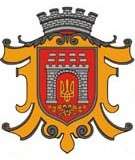
Coat of arms
Chernivtsi coat of arms – framed by a bronze ornamental cartouche, a red heraldic shield depicting an open stone gate with a figured trident in the middle. Under the gate, there are two crossed laurel branches, tied with ribbons. The crown of the symbol is the stone crown.
Flag of Chernivtsi
The Chernivtsi flag consists of a tree, the top, and a rectangular cloth, the front of which forms framed by a red tooth-like ornament white background with an inscription in Ukrainian in the center, over which there is inscribed in Ukrainian: "Chernivtsi". Under the coat of arms, there is the sign "1408" – the date of the first written mention of the city. On both sides of the coat of arms and all four corners of the field are filled with floral ornaments and with the addition of two beech branches with nuts and leaves. The reverse side is formed by a yellow background with the coat of arms of Ukraine in the center with frames and ornaments similar to the front side.
Honorary chain of the mayor of Chernivtsi
The mayor's honorary chain is a symbol of Chernivtsi mayor's authority, which is served on behalf of the territorial community. Founded in 1908 and restored in 2008. The symbol is a medallion with the inscription engraved on it: "From Chernivtsi community to freely elected head", on the reverse – "The foundation of a free state is a free community". The medallion is attached to a chain consisting of stylized coats of arms Ukraine, Chernivtsi region and the city of Chernivtsi. The symbol is made of gold colour metal.
Medal "To the glory of Chernivtsi"
The medal "To the glory of Chernivtsi" is an honorary distinction of the Chernivtsi City Council, introduced to the 600th Anniversary of Chernivtsi (2008) in order to reward individuals who actively contributed to the prosperity of the city and its promotion in Ukraine and the world. The award is made of silver-gilt, it has a circle shape with a diameter of 28 mm. The medal's strip is white with red stripes, which corresponds to the colours of the Chernivtsi flag. At the bottom of the strip, there is a beech branch. The obverse depicts the emblem of Chernivtsi and the inscription – "To the glory of Chernivtsi". On the reverse – the official Chernivtsi logo, designed and approved for the anniversary. The medal is awarded, according to the decision of the Executive Committee of the City Council, annually during the celebration of the city day.
The official motto of modern Chernivtsi, "Спільними зусиллями!", is a Ukrainian-language version of the Latin Viribus Unitis ("With United Forces"), the personal motto of Franz Joseph, who personally bestowed the right to use it on Chernivtsi. This indicates a special attitude of the emperor to the city. Along with the capital of Bukovina, only the first naval ship of the Austro-Hungarian Navy (SMS Viribus Unitis) was honoured with such honour.
Logotype of Chernivtsi
The official ''Chernivtsi 600'' logo was developed and approved by the anniversary of the city in 2008. It was recognized so successful that it continues to be used. The main idea of components for emblem is based on the antiquity of the city, its exceptional architectural heritage and the hard work of its inhabitants. The symbol is made in the form of a blacksmith's work of art, which testifies to the soundness, prosperity, and success. The color scheme of the logo, represented by dark blue and yellow, has a higher degree of comfortable contrast and coincides with the colors of the State Flag of Ukraine.[21]
In the early 2010s, a new city logo was developed and approved, and at the same time the official slogan was affixed: "Chernivtsi is unique in diversity". Old and new symbols of Chernivtsi were chosen for its creation. To the left, in the foreground, there is a trumpet player who wins the trumpet tune "Marichka". In the middle of the background, there is the town hall. The former Metropolitan Residence of Bukovina and Dalmatia which is recognized as the architectural pearl of the city is pictured to the right in the background.
The colour scheme of the logo represented in orange, blue and red, the name is purple. Such a combination is characteristic of tourism, which uses the notion of happiness, well-being, the joy of relaxation, visualizing positive symbols and images in a colourful, warm and vibrant colour scheme. The new logo uses old symbols from the "Chernivtsi 600" logo.
Geography and climate
Chernivtsi is located in the historic region of Bukovina, which is currently shared between Romania (south) and Ukraine (north). Chernivtsi is located in the southwest of Ukraine, in the eastern Carpathians, on the border between the Carpathians and the East European Plain, 40 km from the border with Romania. The city lies 248 meters above sea level and is surrounded by forests and fields. The River Prut runs through the city's landscape. The city is located in the Eastern European time zone in the region of 26 meridians.
The city is located in the heart of the Chernivtsi region between Novoselytsia, Hertsa, Hlyboka, Storozhynets, Kitsman and Zastavna raions (districts).
Chernivtsi is located at the intersection of the transport arteries: E85, H03, and H10
Climate
The city is located in a temperate climate zone. The climate is continental with mild winters and warm summers. The average annual temperature is +8,6 °C, the lowest in January (-2,9 °C), the highest – in July (+19,8 °C). Winter usually comes on November 28 and ends March 9; summer begins on May 20, and ends on September 10. The average annual rainfall in Chernivtsi is 621 mm, with the lowest – in October and January–February, the highest – in June–July. Sometimes there are heavy rains during the summer.[22] Snow cover is formed each winter, but its altitude is insignificant. The average wind speed ranges from 3.3 m/s in July to 4.0 m/s in January. The average annual humidity is 77%.
| Climate data for Chernivtsi (1981–2010, extremes 1941–present) | |||||||||||||
|---|---|---|---|---|---|---|---|---|---|---|---|---|---|
| Month | Jan | Feb | Mar | Apr | May | Jun | Jul | Aug | Sep | Oct | Nov | Dec | Year |
| Record high °C (°F) | 15.3 (59.5) |
21.3 (70.3) |
24.6 (76.3) |
30.9 (87.6) |
33.5 (92.3) |
35.6 (96.1) |
37.4 (99.3) |
37.7 (99.9) |
36.7 (98.1) |
31.0 (87.8) |
24.9 (76.8) |
17.9 (64.2) |
37.7 (99.9) |
| Average high °C (°F) | 0.1 (32.2) |
1.8 (35.2) |
7.2 (45.0) |
14.5 (58.1) |
20.4 (68.7) |
23.1 (73.6) |
25.1 (77.2) |
24.6 (76.3) |
19.6 (67.3) |
13.8 (56.8) |
6.1 (43.0) |
0.9 (33.6) |
13.1 (55.6) |
| Daily mean °C (°F) | −2.9 (26.8) |
−1.8 (28.8) |
2.7 (36.9) |
9.2 (48.6) |
14.9 (58.8) |
18.0 (64.4) |
19.8 (67.6) |
19.1 (66.4) |
14.3 (57.7) |
8.8 (47.8) |
2.6 (36.7) |
−1.9 (28.6) |
8.6 (47.5) |
| Average low °C (°F) | −5.7 (21.7) |
−4.7 (23.5) |
−0.9 (30.4) |
4.6 (40.3) |
9.8 (49.6) |
13.3 (55.9) |
15.1 (59.2) |
14.4 (57.9) |
9.9 (49.8) |
4.9 (40.8) |
−0.2 (31.6) |
−4.4 (24.1) |
4.7 (40.5) |
| Record low °C (°F) | −30.7 (−23.3) |
−29.0 (−20.2) |
−21.7 (−7.1) |
−13.6 (7.5) |
−2.0 (28.4) |
3.0 (37.4) |
7.4 (45.3) |
3.4 (38.1) |
−4.4 (24.1) |
−9.7 (14.5) |
−17.5 (0.5) |
−28.0 (−18.4) |
−30.7 (−23.3) |
| Average precipitation mm (inches) | 26 (1.0) |
30 (1.2) |
32 (1.3) |
47 (1.9) |
76 (3.0) |
88 (3.5) |
96 (3.8) |
75 (3.0) |
50 (2.0) |
36 (1.4) |
33 (1.3) |
33 (1.3) |
622 (24.5) |
| Average rainy days | 7 | 7 | 12 | 17 | 17 | 18 | 15 | 13 | 13 | 13 | 12 | 9 | 153 |
| Average snowy days | 15 | 15 | 10 | 3 | 0.03 | 0 | 0 | 0 | 0 | 1 | 7 | 13 | 64 |
| Average relative humidity (%) | 83 | 81 | 75 | 69 | 69 | 71 | 71 | 73 | 75 | 79 | 84 | 85 | 76 |
| Mean monthly sunshine hours | 65 | 75 | 123 | 162 | 219 | 233 | 247 | 246 | 188 | 141 | 68 | 53 | 1,820 |
| Source 1: Pogoda.ru.net[23] | |||||||||||||
| Source 2: NOAA (sun, 1961–1990)[24] | |||||||||||||
Landscape
The total area of Chernivtsi within the administrative boundaries of 2013 is about 153 km². According to the functional purpose the lands of the city are divided as follows: land of residential and public buildings (64%), lands of agricultural purpose (17%), lands of industry (9%), lands of recreational and environmental purpose (5%), lands of general use (3%), commercial land (2%).[25]
The main water source of Chernivtsi is the Prut River in its upper reaches, which divides the city in half. Besides, there are six small streams and nine lakes within the city.
The relief is characterized by significant relief dip – from 150 m above sea level in the Prut valleys to 537 m in the western outskirts (Mount Tsetzino), which is caused by the location on the Chernivtsi Upland.
Chernivtsi is considered to be a "green city": the large territory is occupied by parks, squares, gardens, alleys and flower gardens. Nine objects are recognized as monuments of landscape art. The city has a botanical garden at the Yuriy Fedkovych National University with a unique orangery. Among the relict plants growing in the botanical garden, a special place is occupied by a giant Sequoiadendron.[26]
Chernivtsi is located in the center of Chernivtsi Regional Park, which borders zakaznik "Thetzino" in the west and Mount Berda in the north.
State of the environment
At the end of the twentieth century, the main pollutants of the Chernivtsi environment were industrial enterprises, including the MIC. In the 1990s much of them ceased to exist or significantly reduced production capacity and thus reduced industrial emissions. Despite this, 58 enterprises (38.4% of the total amount in the region) are the main pollutants of the environment. Approximately 1.2 tonnes of pollutants are released into the air annually (34.9% of the total area emissions). Non-methane volatile organic compounds, carbon dioxide and substances in the form of solid suspended solids predominate in the structure of the emitted pollutants. In addition, carbon dioxide, which has a greenhouse effect, is periodically released into the atmosphere of the city. Emissions from stationary sources were 7.9 tonnes per 1 km² of Chernivtsi territory. Each inhabitant of the regional center accounts for an average of 4.8 kg of harmful emissions per year.[27]
In 2008, Chernivtsi established an Environmental Monitoring System (EMS), an information structure that integrates environmental monitoring organizations and industrial enterprises that pollute the environment or which may adversely affect the environment or its components.[28]
Since the late 1990s, transport is a significant factor in the negative impact on the environment. To some extent, the situation was improved with the construction of the first (2004) and the second (2010) queues of the bypass road, which connected the directions "Kyiv-Chernivtsi" and "Chernivtsi-Suceava". The problem of transit transport in the city will be finally resolved after the construction of the third branch of the bypass road, which will connect the directions "Suceava-Chernivtsi" and "Chernivtsi-Lviv".[29]
Government and subdivisions
Chernivtsi is the administrative center of the Chernivtsi Oblast (province) and the city itself has own government within the oblast under direct subordination to oblast.
The territory of Chernivtsi is divided into three administrative city raions (districts):
| No. | Name | in Ukrainian | Population |
|---|---|---|---|
| 1 | Pershotravnevy Raion | Першотравневий район | 69,370 |
| 2 | Sadhora Raion | Садгірський район | 28,227 |
| 3 | Shevchenko Raion[30] | Шевченківський район | 139,094 |
The mayor of Chernivtsi is Mykola Fedoruk, who has held the position since 1994.[10] The new mayor of Chernivtsi is Oleksiy Kaspruk who has held the position since 2014[10]
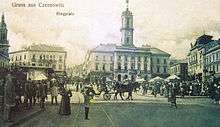 Central Square of Czernowitz in the early 1900s
Central Square of Czernowitz in the early 1900s The Residence (photograph of c. 1899)
The Residence (photograph of c. 1899) Armenian church in the early 1900s.
Armenian church in the early 1900s.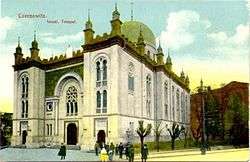 An early 20th-century postcard depicting the Czernowitz Synagogue.
An early 20th-century postcard depicting the Czernowitz Synagogue.
Demographics
| Year | Pop. | ±% |
|---|---|---|
| 1775 | 2,300 | — |
| 1794 | 5,000 | +117.4% |
| 1832 | 11,000 | +120.0% |
| 1869 | 34,000 | +209.1% |
| 1890 | 54,200 | +59.4% |
| 1910 | 87,100 | +60.7% |
| 1930 | 112,400 | +29.0% |
| 1941 | 78,800 | −29.9% |
| 1970 | 187,000 | +137.3% |
| 1984 | 238,000 | +27.3% |
| 1989 | 295,000 | +23.9% |
| 2001 | 240,600 | −18.4% |
| 2013 (est.) | 259,897 | +8.0% |
According to the latest All-Ukrainian population census in 2001, the population of Chernivtsi was approximately 240,600 people of 65 nationalities.[4] Among them, 189,000 (79.8%) are Ukrainians; 26,700 (11.3%) Russians; 10,500 (4.4%) Romanians; 3,800 (1.6%) Moldovans; 1,400 (0.6%) Polish; 1,300 (0.6%) Jews; 2,900 (1.2%) other nationalities.[10]
Based on the last available Soviet data, the population of the city, as of 1 January 1989, was approximately 295,000 residents. Among these, there are some 172,000 Ukrainians, 46,000 Russians, 16,000 Romanians, 13,000 Moldovans, 7,000 Poles and others.
The Romanian population in Chernivtsi started decreasing rapidly after 1950. Many Romanians fled to Romania or were deported to Siberia (where most of them died), and the remaining Romanian population quickly became a minority and assimilated with the majority. Nowadays, the Romanian minority in Chernivtsi is still decreasing as a result of cultural assimilation and emigration to Romania.
Chernivtsi once had a Jewish community of over 50,000, less than a third of whom survived World War II. Romanian lawyer and reserve officer Theodor Criveanu, as well as the then city mayor Traian Popovici, supported by General Vasile Ionescu saved 19,689 Jewish people. Initially, Governor of Bukovina Corneliu Calotescu allowed only 190 Jewish people to stay, but Traian Popovici, after an incredible effort, obtained from the then dictator of Romania Marshal Ion Antonescu an allowance of 20,000.[31] After World War II, the city was a key node in the Berihah network, which helped Jews to emigrate to the then Mandate Palestine from the difficult conditions after the War. Following the collapse of the Soviet Union in 1991, the majority of the remaining Jewish population emigrated to Israel and the United States. A famous member of this latter emigration is the actress Mila Kunis.[32]
Chernivtsi was inhabited by Ukrainians, Romanians, Poles, Ruthenians, Jews, Roma, and Germans. During its affiliation with the Austro-Hungarian monarchy, Chernivtsi enjoyed prosperity and culture as the capital of the Bukovina crown land. Until 1918, the main language of the city was German, which, in addition to the Germans, was also spoken by Jews (together they made up half the population of the city) and even partly by Ukrainians, Romanians and Poles. After World War II, the Shoah and Porajmos, and the resettlement and expulsion of the whole ethnic groups, including Germans and Romanians, this status was diminished. Today, the Ukrainians are the dominant population group.
Chernivtsi's change in demographic diversity is demonstrated by the following population statistics. Once, Romanians and Ukrainians formed the majority of the population. However, after 1870, Yiddish-speaking or German-speaking Jews surpassed the Romanians as the largest population group of the town. After 1880, the Ukrainians surpassed the Romanians as the second-largest population group.
| Jews in Chernivtsi according to Austrian-Hungarian Census[33] | ||||
|---|---|---|---|---|
| Year | Approximate Total Population | Jewish Population | Percentage | |
| 1857 | 22,000 | 4,678 | 21.6% | |
| 1869 | 34,000 | 9,552 | 28.2% | |
| 1880 | 46,000 | 14,449 | 31.7% | |
| 1890 | 54,000 | 17,359 | 32.0% | |
| 1900 | 68,000 | 21,587 | 31.9% | |
| 1910 | 87,000 | 28,613 | 32.8% | |
| Chernivtsi (City) | Chernivtsi (Suburbs) | |||
|---|---|---|---|---|
| Year | Romanians | Ukrainians | Romanians | Ukrainians |
| 1860 | 9,177 | 4,133 | 20,068 | 6,645 |
| 1870 | 5,999 | 5,831 | 28,315 | 35,011 |
| 1880 | 6,431 | 8,232 | 8,887 | 23,051 |
| 1890 | 7,624 | 10,385 | 11,433 | 34,067 |
| 1900 | 9,400 | 13,030 | 13,252 | 25,476 |
| 1910 | 13,440 | 15,254 | 18,060 | 22,351 |
Language composition of the population
Ethno-linguistic composition of the population of the former districts of the city (native languages according to the 2001 census).[34]
| Ukrainian | Russian | Romanian | Moldovian | Polish | Belarusian | |
| Chernivtsi | 79,20 | 15,27 | 3,26 | 1,08 | 0,12 | 0,09 |
| Sadhora Raion | 93,43 | 4,04 | 0,38 | 0,51 | 0,13 | 0,08 |
| Pershotravnevy Raion | 77,45 | 16,22 | 3,53 | 1,43 | 0,12 | 0,09 |
| Shevchenko Raion | 77,19 | 17,08 | 3,70 | 1,02 | 0,12 | 0,09 |
Economy
The total number of economic entities in the city is 25.4 thousand. On January 1, 2006, there were 6739 legal entities – business entities and almost 19,000 private entrepreneurs – individuals, primarily represented by small enterprises. The volume of sales and services provided to small enterprises is UAH 578 million or 22% of the total Chernivtsi volumes. The share of the city's tax revenues is almost 35%. The most attractive for small businesses are trade and services, restaurant and tourist business.
Wholesale and retail trade, industry and construction are successfully developing in Chernivtsi. In 2005, wholesale and retail sales accounted for over 64%, industry – 23%, construction – 6%, real estate operations – 2.3%, transport and communications – more than 2%.
Industry
In the industrial sector of the city, there are 10 branches, which have 70 large enterprises with a total number of employees over 20 thousand people or 13% of the working population of the city. The annual volume of industrial production at these enterprises is about 775 million UAH. The share of citywide tax revenues to the budgets of all levels of the industry is 21%. Defining industries in the city's industry are food, light, mechanical engineering and woodworking. Defining industries in the city's industry are food, light, mechanical engineering and woodworking. Food processing companies produce sugar, bakery products, alcohol, oil, meat and milk, fruits, vegetables and other products. In the light industry, the production of garments, knitwear, hosiery, rubber and leather footwear and textiles prevails. Mechanical engineering is represented by the production of oil and gas processing equipment and agricultural machinery. The timber industry is dominated by the production of lumber, furniture, joinery and other wood products.
Trade and services
In 2005, there were 1922 trade enterprises, 609 restaurants, 892 services in the city. There are 22 markets and micro-markets in the city. 10 million UAH are invested annually in their construction, reconstruction, improvement of trade conditions and creation of facilities for buyers. Chernivtsi City Shopping Complex, "Kalinivskiy Rynok" Municipal Enterprise is a modern multidisciplinary enterprise with powerful infrastructure. The average daily number of market visitors is 50,000 people, served by 9,100 entrepreneurs. The volume of services in 2005 amounted to almost UAH 23 million, more than UAH 18 million was paid into the city budget, or nearly 10% of the total revenues.
Health care
In Chernivtsi concentrated almost all health care establishments of the region. 39 medical establishments (hospitals, clinics, and polyclinics) provide citizens of Chernivtsi with necessary medical care.[35] Medical services are provided by 4.47 thousand people, of which – 1102 doctors, 1902 – average health workers, 1473 – junior and support staff.
Municipal medical establishments provide the following medical services:
- Emergency care (emergency care station);
- Dispensary and polyclinic care (5 municipal polyclinics, a municipal children polyclinic, polyclinics of two maternity houses, a polyclinic of preventive examination and Municipal Dentistry Association, which includes two dentist clinics);
- Specialized medical care (3 hospitals, 2 maternity houses, a tuberculosis hospital and a municipal children hospital);
- Disease-prevention and anti-epidemic services (a municipal sanitary and epidemiological station).
Culture
Throughout centuries Chernivtsi, as the center of Bukovyna, was forming as a multinational city with tolerance atmosphere which became the cradle of artists representing different cultures
The city has 2 theaters, a philharmonic, organ hall (in the Armenian Catholic Church),[36] more than 10 museums, 6 cinemas, 31 libraries, central palace of culture, 4 music schools and fine arts school.[37] The city has more than 100 religious organizations and diocesan authorities, 4 religious institutions. More than a dozen of active non-profit cultural organizations operate in Chernivtsi, including A.Mickiewicz Polish Culture Society, M.Eminescu Romanian Culture Society, Society of Austrian and German Culture.[38]
Since 1997 Chernivtsi has hosted an international art event under "Days of European Culture Heritage" project. Every year "Bukovynian Meetings" folklore festival is held during the City Day in which art groups from Poland, Hungary, Romania and Germany take part.[38]
Important part of Chernivtsi cultural life is Malanka Fest, Ukraine's main carnival timed to the religious St. Melania ("Malanka") Day and St. Basil Day. Respectively, this is usually conducted on January 14, although this date may be moved a bit to match the weekend.[39] During the Festival groups from different towns and settlements of Bukovyna compete in the artistic ingenuity.
One of the biggest literature festival in Ukraine is International Poetic Festival Meridian Czernowitz. The purpose of the festival is to return Chernivtsi to the cultural map of Europe and to develop a dialogue between contemporary Ukrainian poets and their foreign colleagues.[40] The participants of Meridian Czernowitz are famous and interesting poets from Germany, Austria, Switzerland, Great Britain, USA, Denmark, Netherlands, Luxembourg, Liechtenstein, Poland, Romania, Russia, Ukraine and others.[41]
Museums
- Chernivtsi Regional Museum (O. Kobylyanska St., 28) has the largest collection of materials and artefacts of the nature, history, and culture of Northern Bukovina: a collection of old printed books with a unique Ostroh Bible, printed by Ivan Fedorov in 1581; numismatic collection with more than 3 thousand coins; an interesting collection of weapons; an archaeological collection of more than 12,000 museum objects. The pride of the museum is a collection of works of fine and decorative arts, the basis of which consists of icons of the XVI–XVIII centuries, works of prominent Bukovyna artists. The natural collection includes nearly 10,000 natural specimens (stuffed animals, wet preparations, herbarium, entomological collections, etc.);
- Chernivtsi Art Museum (Central Square, 10).[42] The building itself has artistic value: in its design masterfully combined sculpture, painting, stained glass, artistic metal. The total number of exhibits in the museum exceeds 8400. A collection of unique Bukovyna folk images and icons on glass of the XIX–XX centuries, Bukovyna folk rugs of the XIX–XX centuries, Bukovina and Hutsul pysankas are saved here, as well as such rare monuments as the composition " Last Judgment ", Bukovynian icons of the XVII–XX centuries. and old printed books, including "The Apostle" 1632. The paintings of the Art Museum feature, in general, rare canvases belonging to the brushes of famous Bukovyna painters who worked predominantly in a classical manner.
- History and Culture Museum of Bukovinian Jews (Theater Square, 10).[43] Located in the former Jewish People's House (now the Central City Palace of Culture). The main concept of the museum is to reflect and emphasize the characteristics of Bukovina Jewry – the Bukovina phenomenon of the XIX – early XX, which differed significantly from the phenomena of neighbouring Galician, Bessarabian and Podolian Jewry.
- Museum of the Bukovina Diaspora (Josef Hlávka St., 1);
- Chernivtsi Regional Museum of Folk Architecture and Life (Svitlovodska Street, 2) is an architectural and landscape complex consisting of monuments of folk architecture of the late XVIII – first half of XX centuries.[44] An ancient village of Bukovina is open to the sky, where you can get acquainted with the folk architecture and way of life of Bukovinians from different regions and ethnographic groups. The exposition of the museum includes about 35 structures, transported from different parts of the region and reconstructed in original form with appropriate natural surroundings.
- Olga Kobylyanska Literary Memorial Museum (Okunevska St., 5);
- Yuriy Fedkovich Literary Memorial Museum (Soborna Square, 10);
- Volodymyr Ivasyuk Memorial Museum (Mayakovsky St., 40/1);
- Aviation and Space Museum.
Architecture
There are many places which attract citizens of Chernivtsi and the visitors: Drama Theatre, Regional Philharmonic Society, Organ and Chamber Music Hall, puppet-theatre, Museum of Local Lore, History and Economy, Museum of Fine Arts, Bukovynian Diaspora Museum, Museum of Folk Architecture and Way of Life, memorial museums of writers, the Central Palace of Culture, the Star Alley in Teatralna Square.

The city of Chernivtsi has a lot of architecturally important buildings. Many historic buildings have been preserved, especially within the city's center. However, after years of disrepair and neglect, the buildings are in need of major restoration.
As Chernivtsi was part of the Austro-Hungarian Empire, it was closely related to the empire's culture, including architecture. Main architectural styles present within the city include Vienna Secession and Neoclassicism, Baroque, late Gothic architecture, and fragments of traditional Moldavian and Hungarian architecture, Byzantine architecture as well as Cubism.[45] During the Interwar Romanian administration, a great number of buildings in the Neo-Romanian and Art Deco architectural styles were also built.The city is sometimes dubbed Little Vienna, because its architecture is reminiscent of the Austro-Hungarian capital Vienna.[1][2]

The main architectural attractions of the city include: the Chernivtsi Drama Theater (1905); the Chernivtsi University—UNESCO World Heritage Site (1882); the Regional Museum of Fine Arts—the former savings bank (1900); the Regional Council—former Palace of Justice (1906); and the Chernivtsi Palace of Culture—former Jewish National House (1908); among many others. The magnificent Moorish Revival Czernowitz Synagogue was heavily damaged by fire in 1941, the walls were used to create the "Chernivtsi" movie theater.[46]

The Czech architect Josef Hlávka designed, in 1864–1882, the buildings that currently house the Chernivtsi State University. They were originally the residence of the Bukovinian and Dalmatian Metropolitans. The Romanesque and Byzantine architecture is embellished with motifs of Ukrainian folk art; for example, the tile roof patterns duplicate the geometric designs of traditional Ukrainian embroidery.
Polish National House in Chernivtsi

The history of the Polish community in Chernivtsi dates back to the late 18th century, when authorities of the Habsburg Empire encouraged Poles to move to Bucovina. By the mid-19th century, several Polish organizations existed in the city, including Bratnia Pomoc and Czytelnia Polska. On the initiative of publishers of the Gazeta Polska daily newspaper, collection of money for the construction of Polish House was initiated.[47] In early 20th century, two Polish activists, doctor Tadeusz Mischke and judge Jakub Simonowicz purchased a house. In 1904, its expansion was initiated. It was carried out by architect Franciszek Skowron, interior decorator Konrad Górecki and sculptors from Zakopane, Skwarnicki and Gerasimowicz. The expansion was completed in 1905, and Polish House operated until World War II.
In 1945, Soviet authorities opened here a cinema, later a music school. Currently, the complex houses Adam Mickiewicz Association of Polish Culture.
Apart from the Polish House, Chernivtsi also has German, Romanian and Jewish Houses.
German National House in Chernivtsi

It was built in the early 20th century by the union of the German community in Chernivtsi, which became the center of German cultural and social life in Chernivtsi and Bukovina.[48] German House was built in 1908–1910 according to plans developed by architect Gustav Fric.[49] The building measures 1700 square meters, 25000 cubic meters. built as a profitable house and a partnership house for 700,000 kroons on the site of the old German school building. The German House also had its own bank, and its own printing house, where various books, brochures, newspapers, and magazines were published, including the newspaper "German diary", which was popular at the time.
Jewish National House in Chernivtsi
House was built in 1908 by the Jewish community and until the Second World War, it was the center of Jewish life in Chernivtsi and home to various Jewish associations and organisations. At least 45,000 Jews from the Bukovina region fell victim to mass shootings, forced labour and deportations beginning 1941.[50] With the advent of the Soviet government (1944), the building was transferred to the City House of Culture. Today it is the Central Palace of Culture of Chernivtsi
Religion
- Cathedral of the Holy Spirit (Svyatodukhivsky Cathedral) is a cathedral of the Ukrainian Orthodox Church (Moscow Patriarchate) in Chernivtsi. The first stone in its foundation was laid in July 1844. The construction was carried out under the supervision of local engineer A. Marin and Viennese architect A. Röll. In 1860 the facade of the temple was rebuilt under the design of Josef Hlavka. Twenty years after the work began in July 1864, Bishop Yevgeny Hakman consecrated the Cathedral. However, interior decoration work continued until the end of the century. In 1892–1896 a group of artists from Vienna painted the walls. It was built in the style of the Italian Renaissance, and one of the projects of the St. Isaac's Cathedral, which was presented to Bishop Yevgeny Hakman during his pilgrimage to the Trinity Lavra of St. Sergius.
- The Ukrainian Greek Catholic Church has a large number of believers in Chernivtsi who are increasing every year. Currently, several temples have been built in the city. The main temple representing the UGCC in Bukovina is the Cathedral of the Assumption of the Blessed Virgin Mary, which was recently 190 years old. It also bears the title of the oldest temple built in Bukovina over the last several centuries. On September 12, 2017, Pope Francis confirmed the decision of the Synod of Bishops of the UGCC to establish a separate Chernivtsi eparchy and to appoint its Bishop Yosafat Moschych.
- The Armenian Church of Chernivtsi is the existing Armenian Catholic Church of the Eastern Rite of the Holy Apostles Peter and Paul in the city of Chernivtsi. The temple was built and consecrated in 1875. He functioned intermittently during the Soviet rule in Bukovina. The temple is included in the list of city buildings protected by the law of Ukraine.
- Basilica of the Exaltation of the Holy Cross (Chernivtsi) is a Roman Catholic church with the status of a small basilica, the first stone building of the city. Its history begins when Bukovina joined Austria in 1774. At the time of Bukovina's annexation to Austria, there were no Roman Catholic temples in the province. The first holy mass was held at the wooden house of General Gabriel von Spleny, the first Austrian governor of Bukovina, attended by only a small number of Roman Catholics. In 1778 the building of the first church in Chernivtsi was completed. The architectural structure of the Church of the Exaltation of the Holy Cross is characterized by classic features. There are also numerous chapels and churches in different districts of the city.
The Residence of Bukovinian and Dalmatian Metropolitans is included in the UNESCO list of Architectural Heritage.
Education
Chernivtsi is a known scientific and educational center in Western Ukraine. Research Institutes of Thermoelectricity, the Institute of Medical and Ecological Problems of the Ministry of Health Care of Ukraine, Chernivtsi National University, Bukovinian State Medical University, Trade and Economics Institute, Institute of Economics and Law, Bukovinian State Institute for Finance and Economics.[51][52]
Secondary education in Chernivtsi is provided by:
- 46 high schools with the Ukrainian language of study – 97.3% of students;
- 4 high schools with the Romanian language of study – 2.7%;[51]
- 2 private schools: Hope and Harmony.[53]
- 3 lyceums and 7 gymnasium.
There are 5 gymnasiums, 3 lyceums, and 3 sport schools, the Municipal Center of Science, "Young Technicians" Club, "GERDAN" Theatre-Studio.[54][55]
There are 15 higher educational institutions (universities, institutes, colleges). Among them:
- Yuriy Fedkovych Chernivtsi National University (19227 students) – one of the few classic universities in the country. It was opened on October 4, 1875, according to the decree of the Austrian Emperor Frans Joseph. At that time the university consisted of three faculties: philosophical, theological and law. Today, 16 faculties and the Chernivtsi Pedagogical College within the ChNU are functioning at the university. Almost 13,000 students study in 61 specialities; the main areas of preparation are the natural sciences, and the humanities. This is the only university in the country where civilian theologians are trained.
- Bukovinian State Medical University (4321 students). The teaching process at the 42 departments is provided by 75 doctors and 321 candidates of sciences. The teaching staff provides training for 4,474 students, including 675 students from 35 countries. Foreign students are taught in English. The Faculty of Postgraduate Education trains about 800 interns and over 2000 attending physicians; the university provides continuity and continuity of higher medical education: junior specialist, bachelor, doctor-specialist, master, graduate student. BSMU prepares specialists in the specialties "Medical Affairs", "Pediatrics", "Dentistry", "Medical Psychology", "Clinical Pharmacy", "Pharmacy", "Nursing", "Laboratory diagnostics".
- Chernivtsi Trade-Economics Institute of the Kyiv National University of Trade and Economics (2315 students).[56] The university trains specialists in the field of internal and foreign trade, restaurant business, state financial system and law, customs service, antitrust activity, business economics, banking and insurance, tax and accounting and control, audit, tourism, hospitality, household and other links in the infrastructure.
- Bukovinian University (the first private higher educational institution in the region) – 1,273 students.[57]
- Bukovynskyi State Institute for Finance and Economics – 1,268 students.[58]
- Chernivtsi Branch of the Interregional Academy of Personnel Management.
Sports
The most popular kinds of sports in Chernivtsi include archery, judo, field hockey, karate, power-lifting and orienteering.[59] Chernivtsi's baseball, hockey, and football clubs (FC Bukovyna Chernivtsi) are participants of the Ukrainian national championships.
Chernivtsi has a large number of sports establishments and facilities, including 5 stadiums, 186 sports grounds, 2 tennis courts, 11 football fields, 5 skating rinks, 21 shooting galleries, 3 swimming pools, 69 gyms, 62 gyms with special training equipment and an international motorcycle racing track.[59]
Over 7,950 inhabitants are members of sport clubs within the city, and more than 50,000 people participate in various sport activities.[59] Currently, 8 sportsmen from the city are the members of national teams and 12 are members of national youth teams.[59] 3 athletes from Chernivtsi were prize-winners in various world tournaments, 2 were winners of European and 42 of national championships in 2002.[59]
Chernivtsi has been host to the Sidecross World Championship a number of times,[60] most recently in June 2010.[61]
Transport
Chernivtsi public transport divides on two groups: trolleys and buses. All modes of transport are very cheap – 0.20 $. In 2018, Chernivtsi has begun testing its innovative hybrid trolleybuses. The new trolleybuses are designed to improve the public transport system of Chernivtsi by making it more energy-efficient, as well as covering the part of the town which currently has no trolleybus lines.[62]
Rail
Chernivtsi–Berehomet line | |||||||||||||||||||||||||||||||||||||||||||||||||||||||||||||||||||||||||||||||||||||||||||||||||||||||||||||||||||||||||||||||||||||||||||||||||||||||||||||||||||||||||||||||||||||||||||||||||||||||||||||||||||||||||||||||||||||||||||||||||||||||||||||||||||
|---|---|---|---|---|---|---|---|---|---|---|---|---|---|---|---|---|---|---|---|---|---|---|---|---|---|---|---|---|---|---|---|---|---|---|---|---|---|---|---|---|---|---|---|---|---|---|---|---|---|---|---|---|---|---|---|---|---|---|---|---|---|---|---|---|---|---|---|---|---|---|---|---|---|---|---|---|---|---|---|---|---|---|---|---|---|---|---|---|---|---|---|---|---|---|---|---|---|---|---|---|---|---|---|---|---|---|---|---|---|---|---|---|---|---|---|---|---|---|---|---|---|---|---|---|---|---|---|---|---|---|---|---|---|---|---|---|---|---|---|---|---|---|---|---|---|---|---|---|---|---|---|---|---|---|---|---|---|---|---|---|---|---|---|---|---|---|---|---|---|---|---|---|---|---|---|---|---|---|---|---|---|---|---|---|---|---|---|---|---|---|---|---|---|---|---|---|---|---|---|---|---|---|---|---|---|---|---|---|---|---|---|---|---|---|---|---|---|---|---|---|---|---|---|---|---|---|---|---|---|---|---|---|---|---|---|---|---|---|---|---|---|---|---|---|---|---|---|---|---|---|---|---|---|---|---|---|---|---|---|
| |||||||||||||||||||||||||||||||||||||||||||||||||||||||||||||||||||||||||||||||||||||||||||||||||||||||||||||||||||||||||||||||||||||||||||||||||||||||||||||||||||||||||||||||||||||||||||||||||||||||||||||||||||||||||||||||||||||||||||||||||||||||||||||||||||
There are three railway stations in Chernivtsi: Central Station (38 Gagarina Street.,1.5 km North from the centre), Chernivtsi-Pivnichna Railway station (Zavods'ka str., 13 (North-West 3 km) and Chernivtsi-Pivdenna Railway station (Malovokzalna str., 21 (South 5 km)
Air
Chernivtsi is served by the Chernivtsi International Airport (CWC) located 6 km south of the city centre (Chkalova Str., 30). Flights to Kyiv, Athens, Istanbul and Naples among others.
International relations
Twin towns—Sister cities
The first international contacts with the city were established on July 20, 1989, when then-Mayor of Chernivtsi City Council Pavel Kaspruk, signed a twinning agreement with the Mayor of Salt Lake City (USA) – Lowell Turner. To commemorate this event, the Cradle of Peace was erected in Chernivtsi.
Chernivtsi is twinned with:
| Country | City/Town | County / District / Region / State | |||
|---|---|---|---|---|---|
| Austria | Klagenfurt | Carinthia | |||
| Canada | Saskatoon | Saskatchewan | |||
| Israel | Nazareth Illit | Northern District | |||
| Poland | Konin | Konin County | |||
| Romania | Suceava | Suceava County, Bucovina | |||
| Romania | Iași | Iași County, Moldavia | |||
| Romania | Timișoara | Timiș County, Banat | |||
| United States | Salt Lake City | Utah |
In February 2016 the Chernivtsi city council terminated its twinned relations with the Russian cities Bryansk and Podolsk due to the Ukrainian crisis.[63][64]
Notable people
Natives
- Aharon Appelfeld (1932–2018), Jewish writer
- Ninon Ausländer (1895–1966), art historian and wife of Hermann Hesse
- Rose Ausländer (1901–1988), Jewish German-language writer
- Elyakim Badian (1925–2000), Israeli politician
- Charles K. Bliss (1897–1985), inventor of Blissymbolics
- Ion Bostan (1914–1992), Romanian film director
- Octav Botnar (1913–1998), Romanian businessman, philanthropist, billionaire
- Josef Burg (1912–2009), last Yiddish poet in Chernivtsi
- Paul Celan (1920–1970), German-language poet and translator
- Erwin Chargaff (1905–2002), Jewish biochemist
- Eugen Ehrlich (1862–1922), Jewish jurist, pioneer of the field of sociology of law
- Natalia Fedner (born 1983), Ukrainian-American fashion designer
- Moysey Fishbeyn (1947-2020), a Ukrainian poet
- Max Glücksmann (1875–1946), Argentine Jewish pioneer of the music and film industries
- Radu Grigorovici (1911–2008), Romanian physicist
- Dmytro Hnatyuk (1925–2016), a Ukrainian baritone opera singer
- Frederick John Kiesler (1890–1965), a theater designer, artist, theoretician and architect
- Ruth Klieger Aliav (1914–1979), Romanian-Israeli Jewish activist
- Sam Kogan (1946–2004), stage director, actor and founding principal of the Academy of the Science of Acting and Directing in London
- Mila Kunis (born 1983), American actress[65]
- Ani Lorak (born 1978), Ukrainian singer, songwriter, actress
- Eusebius Mandyczewski (1857–1929), Ukrainian musicologist and composer
- Itzik Manger (1901–1969), Yiddish writer
- Georg Marco (1863–1923), Austrian chess player and author
- Volodymyr Melnykov (born 1951), Ukrainian poet, writer and composer
- Jan Mikulicz-Radecki (1850–1905), Polish surgeon
- Ingrid Nargang (1929–2019), Austrian lawyer and contemporary historian
- Dan Pagis (1930–1986), Israeli writer
- Emil Paur (1855–1932), conductor
- Traian Popovici (1892–1946), Romanian lawyer, mayor of Chernivtsi, and a Righteous Among the Nations for saving 20,000 Jews during the Holocaust
- Iacob Pistiner, lawyer and Member of the Romanian Parliament in the interwar years
- Aron Pumnul (1818–1866), Romanian philologist and teacher, national and revolutionary activist
- Bernard Reder, sculptor
- Markus Reiner (1886–1976), one of the founders of rheology
- Gregor von Rezzori (1914–1998), German-language writer of Sicilian-Austrian origin
- Ludwig Rottenberg (1864–1932), conductor and composer
- Maximilien Rubel (1905–1996), Marxist historian
- Lev Shekhtman (born 1951), Russian-American theater director and actor
- Ze'ev Sherf (1904–1984), Israeli Minister of Finance
- Jan Tabachnyk (born 1945), singer and composer
- Sidi Tal (1912–1983), singer and actress
- Inna Tsymbalyuk (born 1985), Ukrainian model and actress; semifinalist at Miss Universe 2006.
- Viorica Ursuleac (1894–1985), Romanian opera singer (dramatic soprano)
- Sofia Vicoveanca (born 1941), Romanian singer of popular music from the Bukovina region
- Roman Vlad (1919–2013) Romanian-Italian composer, pianist, and musicologist
- Sydir Vorobkevych (1836–1903) Ukrainian composer and writer
- Ruth Wisse, professor of literature
- Mariya Yaremchuk (born 1993), Ukrainian singer, represented Ukraine in the Eurovision Song Contest 2014
- Arseniy Yatsenyuk (born 1974), Ukrainian politician
- Frederic Zelnik (1885–1950), an important German silent movie director-producer
Residents
- Moyshe Altman (1890–1981), Yiddish writer
- Hermann Bahr
- Nicolae Bălan (1882–1955), Romanian cleric, a metropolitan bishop of the Romanian Orthodox Church
- Grigore Vasiliu Birlic (1905–1970), Romanian actor
- Nathan Birnbaum
- Charles K. Bliss
- Nikolay Bogolyubov
- Traian Brăileanu (1882–1947), Romanian sociologist and politician
- Romulus Cândea (1886–1973), Romanian ecclesiastical historian
- Erwin Chargaff
- Nicolae Cotos (1883–1959), Romanian theologian
- Mihai Eminescu (1850–1889), Romanian poet, novelist and journalist
- Iancu Flondor (1865–1924), Romanian activist who advocated Bukovina's unifion with the Kingdom of Romania
- Jacob Frank (1726–1791), Polish rabbi and founder of Frankism
- Ivan Franko
- Karl Emil Franzos (1848–1904), Jewish writer and publicist, grew up in Chernivtsi and wrote a literary memorial of the Jewish ghetto, The Jews of Barnow
- Constantin Isopescu-Grecul (1871–1938), Romanian jurist, politician and journalist
- Gala Galaction (1879–1961), Romanian writer
- Abraham Goldfaden, active here
- Zygmunt Gorgolewski
- Ion Grămadă (1886—1917) Romanian writer, historian and journalist
- Maximilian Hacman (1877–1961), Romanian jurist
- Hans Hahn
- Volodymyr Ivasyuk
- Joseph Kalmer
- Leonid Kravchuk
- Olha Kobylyanska
- Zvi Laron
- Anastasiya Markovich (born 1979), painter
- Karol Mikuli (1821–1892), Romanian pianist and composer, student of Frédéric Chopin
- Ivan Mykolaychuk (1941–1987)
- Grigore Nandriș (1895–1968), Romanian linguist, philologist and memoirist
- Miron Nicolescu (1903–1975), Romanian mathematician
- Ion Nistor (1876–1962), Romanian historian and politician
- Dimitrie Onciul (1856–1923), Romanian historian
- Israel Polack
- George Popovici (1863–1905), Romanian agrarian politician, jurist and poet
- Ciprian Porumbescu (1853–1883), Romanian composer
- Aron Pumnul (1818–1866), Romanian philologist and teacher, national and revolutionary activist
- Florin Piersic (born 1936), Romanian actor and TV personality
- Wilhelm Reich (1897–1957), Jewish psychoanalyst and sexologist, born in Dobrzanica, went to school in Chernivtsi
- Eric Roll, Baron Roll of Ipsden (1907–2005),
- Sofia Rotaru (born 1947), Romanian-Ukrainian pop singer
- Wojciech Rubinowicz
- Ion G. Sbiera (1836–1916), Romanian folklorist and historian
- Josef Schmidt (1904–1942) singer, actor and cantor
- Fritz von Scholz (1896–1944), SS officer
- Joseph Schumpeter (1883–1950), economist and Minister of Finance, 1909–1911, professor in Chernivtsi
- Wilhelm Stekel (1868–1940), Jewish psychoanalyst and sexologist, born in Boiany, Bukowina, grew up in Chernivtsi and attended the Gymnasium (grammar school)
- Vasile Tărâțeanu (born 1945), Romanian journalist and writer
- Nazariy Yaremchuk (1951–1995), Hutsul singer
Gallery
See also
References
- Zhytariuk, Natalia. "Bukovyna Week in Austria". Den. Retrieved 26 September 2007.
- "Bukovina. The beech tree land". Ukraine Cognita. Archived from the original on 28 July 2011. Retrieved 26 September 2007.
- (in Ukrainian) Kaspruk win in Chernivtsi
- "About number and composition population of CHERNIVTSI REGION by data All-Ukrainian Population Census '2001". Archived from the original on 26 December 2005. Retrieved 2012-12-05.CS1 maint: BOT: original-url status unknown (link)
- "Чисельність наявного населення України (Actual population of Ukraine)" (PDF) (in Ukrainian). State Statistics Service of Ukraine. Retrieved 1 July 2016.
- Указ Президиума Верховного Совета СССР от 9 августа 1944 года Об уточнении наименований городов:…Черновицы,…Украинской ССР
- "Trypillya – a culture that was contemporaneous with Ancient Egypt and Mesopotamia". Welcome to Ukraine. Retrieved 27 September 2007.
- Верменич Я.В. (2013). ЧЕРНІВЕЦЬКА ОБЛАСТЬ. Encyclopedia of Ukrainian History (in Ukrainian). 10. Naukova Dumka, NASU Institute of History of Ukraine. ISBN 978-966-00-1359-9.
У 9—11 ст. на території Ч.о. жили племена тиверців і хорватів. Із кінця 10 — в 11 ст. рівнинна частина сучасної області стала периферією Київської Русі, потім — Галицького князівства, а в 2-й пол. 14 ст. відійшла до Молдавського князівства (яке в 16 ст. стало васалом Османської імперії).
- "City of Chernivtsi – History". The Komkon Site. Archived from the original on 27 September 2007. Retrieved 25 September 2007.
- "History". Chernivtsi City Official Site. Retrieved 25 September 2007.
- (in Romanian) Cetatea Ţeţina – Cernăuţi, Astra, 3 (13), 1998
- (in Romanian)Cernăuţi-600 de ani de atestare documentară internă, Astra, 4 (54), 2008, p.3
- Geographical Etymology – a dictionary of place-names giving their derivations, Christina Blackie (1887)
- "Chernivtsi". Ukrainian heraldry. Retrieved 25 September 2007.
- Ion Lihaciu, Czernowitz 1848–1948. Das kulturelle Leben einer Provinzmetropole, Parthenon Verlag, Kaiserslautern und Mehlingen 2012, ISBN 978-3-942994-00-2
- "Bukovina". Encyclopædia Britannica. Retrieved 26 September 2007.
- https://gr-czernowitz.livejournal.com/2727944.html
- "Bukovinian Schindler". DT.ua. Retrieved 28 December 2019.
- "Bukovinian Schindler – former mayor of Chernivtsi". Чернівці, Чернівецька область – новини в газеті Версії (in Ukrainian). 15 September 2011. Retrieved 28 December 2019.
- (in Ukrainian) Chernivtsi banned signs with the word "Russia", Ukrayinska Pravda (4 April 2016)
- "The logo of the 600th anniversary of Chernivtsi was presented".
- "Chernivtsi went under water after heavy rains".
- "Pogoda.ru.net" (in Russian). Weather and Climate (Погода и климат). May 2011. Archived from the original on 14 December 2019. Retrieved 13 December 2019.
- "CERNOVCY Climate Normals 1961–1990". National Oceanic and Atmospheric Administration. Retrieved 17 December 2012.
- "Discussion of the Strategic Plan for the Development of the City of Chernivtsi for 2012 – 2016".
- "The reconstructed Botanical Garden greenhouse will be higher than the Ferris wheel".
- "State of environment of the Chernivtsi in 2009".
- "Моніторимо довкілля". Чернівці, Чернівецька область – новини в газеті Версії (in Ukrainian). 6 June 2008. Retrieved 20 January 2020.
- "Об'їздна дорога в Чернівцях". Чернівці, Чернівецька область – новини в газеті Версії (in Ukrainian). 1 April 2008. Retrieved 20 January 2020.
- The raion was formerly named Lenin Raion. The raion was renamed in accordance with the Rivne Oblast Council's decision.
- "Righteous Among the Nations Ceremony from Romania Tomorrow". Yad Vashem. Archived from the original on 16 November 2008. Retrieved 21 April 2009.
- Міла Куніс зіграє у трилері "Чорний лебідь", Gazeta.ua (13 August 2009) (in Ukrainian)
- Ergebnisse der Volkszählungen der K. K. Statistischen Central-Kommission u.a., in: Anson Rabinbach: The Migration of Galician Jews to Vienna. Austrian History Yearbook, Volume XI, Berghahn Books/Rice University Press, Houston 1975, S. 46/47 (Table III)
- "Database of census in 2001".
- "Health Care". Chernivtsi City Council.
- "ARMENIAN CATHOLIC CHURCH". bukovyna.in.ua. Retrieved 24 January 2020.
- "Culture". Chernivtsi City Counsil.
- "CULTURE". bukovyna.in.ua. Retrieved 24 January 2020.
- "Malanka Fest". www.malankafest.com.ua. Retrieved 24 January 2020.
- "Über das Festival | Internationale Literarische Korporation MERIDIAN CZERNOWITZ" (in German). Retrieved 24 January 2020.
- "TeilnehmerInnen (2010–2019) | Internationale Literarische Korporation MERIDIAN CZERNOWITZ" (in German). Retrieved 24 January 2020.
- "Official web-page of Chernivtsi Art Museum".
- "Web-page of History and Culture Museum of Bukovinian Jews".
- "MUSEUM". ЧЕРНІВЕЦЬКИЙ ОБЛАСНИЙ МУЗЕЙ НАРОДНОЇ АРХІТЕКТУРИ ТА ПОБУТУ. Retrieved 24 January 2020.
- "Sport & Tourism II". Chernivtsi City Official Site. Retrieved 25 September 2007.
- Maria Danilova (24 November 2012). "With few Jewish neighbors, residents of Ukrainian town attend 'cinegogue'". timesofisrael.com.
- "POLISH HOUSE". bukovyna.in.ua. Retrieved 23 January 2020.
- "Deutsches Volkshaus in Czernowitz". www.philhist.uni-augsburg.de. Retrieved 23 January 2020.
- "Deutsches Haus". www.ehpes.com. Retrieved 23 January 2020.
- "Chernivtsi Museum of the History and Culture of Bukovinian Jews". STIFTUNG DENKMAL FÜR DIE ERMORDETEN JUDEN EUROPAS.
- "education in Chernivtsi". City Council.
- "About BSMU | Bukovinian State Medical University". Retrieved 24 January 2020.
- "Приватна школа Надія – Приватна загальноосвітня школа І-ІІ ступенів "НАДІЯ"" (in Ukrainian). Retrieved 24 January 2020.
- "Theatre Gerdan". www.facebook.com. Retrieved 24 January 2020.
- "About Gerdan". www.gerdan.info. Retrieved 24 January 2020.
- "Chernivtsi Trade and Economics Institute". chtei-knteu.cv.ua. Retrieved 24 January 2020.
- "Буковинський університет – Main". www.bukuniver.edu.ua. Retrieved 21 May 2019.
- "Bucovina State University of Finance and Economics | Admission | Tuition | University". www.unipage.net. Retrieved 24 January 2020.
- "Sport & Tourism". Chernivtsi City Official Site. Retrieved 25 September 2007.
- VENUES USED IN GP 1971–2005 The John Davy Pages, accessed: 2 November 2009
- FIM Sidecarcross World Championship—2010 Calendar Archived 12 August 2011 at the Wayback Machine FIM website, accessed: 30 October 2009
- (in Ukrainian) Chernivtsi decided to terminate the relationship with twin two Russian cities, The Ukrainian Week (February 27, 2016)
- "Podolsk sister cities". Translate.google.com. Retrieved 29 April 2010.
- (in Ukrainian) Міла Куніс зіграє у трилері "Чорний лебідь", Gazeta.ua (13 August 2009)
External links
| Wikivoyage has a travel guide for Chernivtsi. |
| Wikimedia Commons has media related to Chernivtsi. |
| Look up chernivtsi in Wiktionary, the free dictionary. |
| Wikisource has the text of the 1905 New International Encyclopedia article Czernowitz. |
- Information Portal Chernivtsi
- "Main Page". Chernivtsi City Official Site/English. Archived from the original on 26 September 2011. Retrieved 12 April 2010.
- "Main Page". Chernivtsi City Official Site/English(mirror). Retrieved 12 December 2009.
- Chernivtsi article by Vladislav Davidzon Tablet Magazine
- "Per le vie di Chernivtsi, città dei sogni yiddish" article by Tommy Cappellini Corriere del Ticino (Italian)
- Chernivtsi Photos
- Chernivtsi, Ukraine at JewishGen
- Virtual 3D Tour
